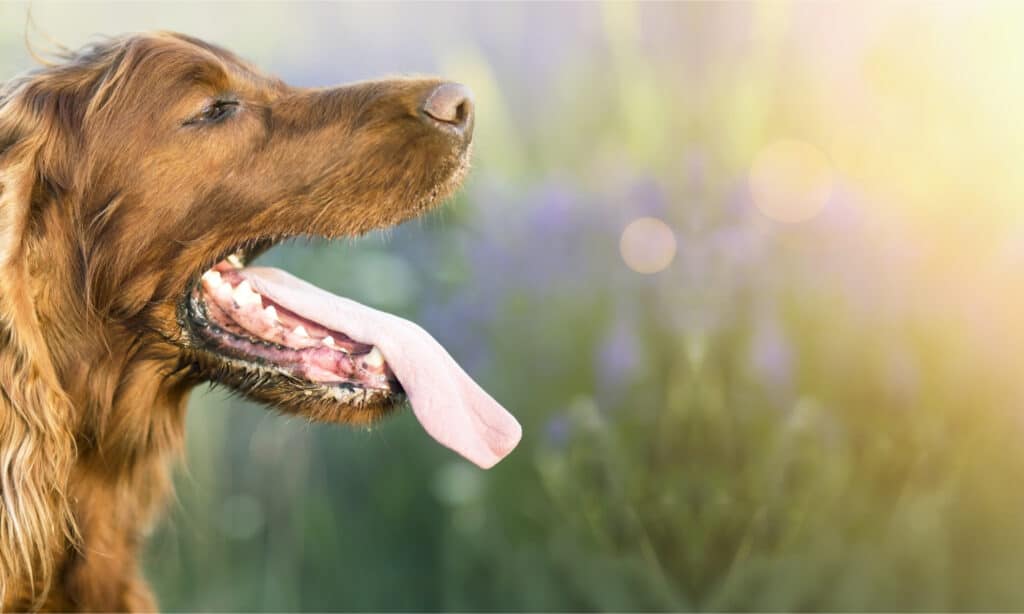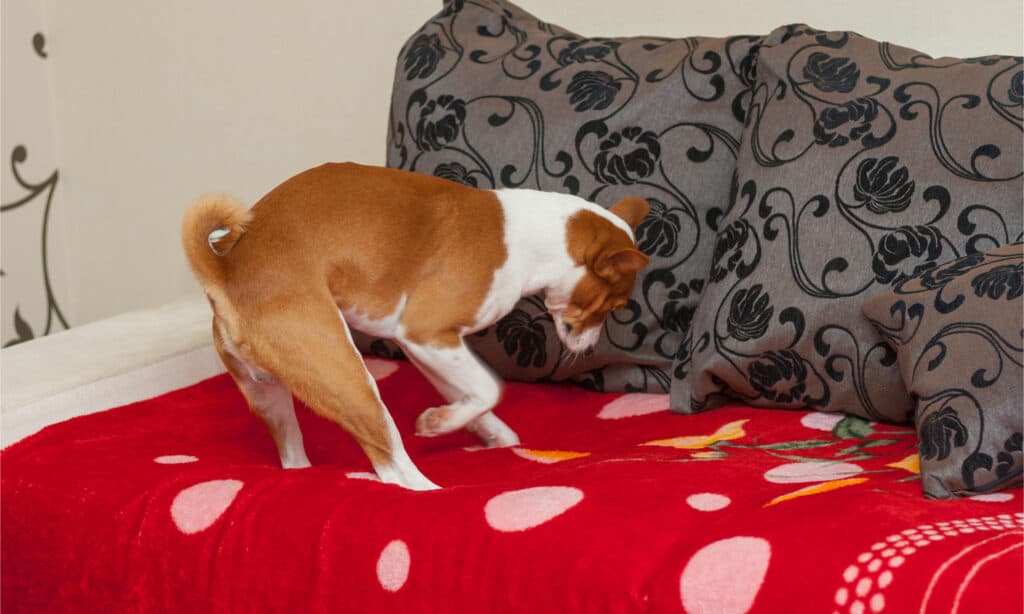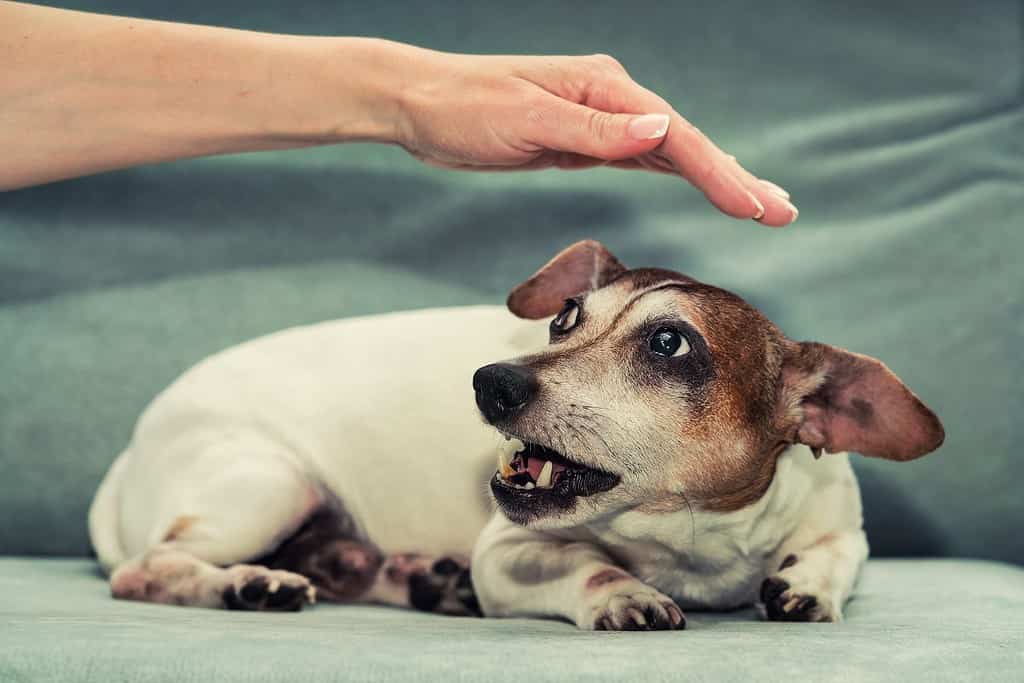Preparing a dog for labor is equal parts exciting and intimidating. You want to make sure the pup is both emotionally and physically supported when she’s giving birth, and a major part of accommodating your dog’s pregnancy is understanding the signs of pre- and active labor. (Keep in mind that dogs can be in labor for up to 24 hours.)
Here are seven visual signs your dog is likely going into labor — and soon.
1. Restlessness

It can be hard for a pregnant dog to get comfortable when she’s nearing labor.
©Nina Buday/Shutterstock.com
If your dog seems restless, it might be a sign that she is about to go into labor. Your dog might start pacing, moving from room to room, or appearing unable to get comfortable in a certain position.
Additionally, you might notice your pregnant pup exhibiting signs of anxiety, which can contribute to the restlessness you’re witnessing. Just like humans, dogs become uncomfortable toward the end of their pregnancy as well, which will make anyone feel restless in their body.
2. Panting

Panting is often a sign of exhaustion in dogs.
©Reddogs/Shutterstock.com
Another common sign your dog is about to go into labor is panting. Similar to when your dog gets overheated, she might begin to display excessive panting from the physical exertion of the pregnancy. In fact, this might even be an indication that contractions have started, as the pain can cause labored breathing. At this time, it’s important to take your dog into a quiet area and prepare for her to give birth.
3. Digging and Scratching

Dogs often scratch and dig at their bed before they go into labor.
©Yuri Kravchenko/Shutterstock.com
Just as humans prepare for the birth of their newborns, so do dogs. This process is called nesting, which might look like digging into or scratching at blankets or other bedding. Your pregnant dog might even carry her bed to two different parts of the house to prepare your home for her newborn pups.
Additionally, if you’ve set up a whelping box or den within your home, your dog might be spending more time in that area, indicating that she will soon go into labor. This is meant to protect the puppies once they’re born by keeping them safely contained in a specific area of your home. If you have not set up a whelping box or nesting corner, do so as soon as possible so your dog can start settling in and preparing for the birth of her pups.
4. Poor Appetite

There are many reasons why a dog doesn’t won’t eat, including stress, anxiety, and discomfort.
©Zontica/Shutterstock.com
Another visual sign your dog is heading toward labor is a lack of appetite. It’s important to keep tabs on how much your dog is eating throughout its pregnancy. If you notice a decrease in your dog’s appetite toward the end of her pregnancy, this might indicate she’s going into labor. When a dog is extremely uncomfortable, anxious, or tired — as she would be before giving birth — she likely won’t want to eat as much as normal. In fact, she might even start vomiting.
5. Enlarged Mammary Glands

The mammary glands are located on the dog’s abdomen.
©2134626691/Shutterstock.com
A telltale sign that your dog’s pregnancy is progressing to labor is enlarged mammary glands. These are the pairs of glands that appear on a dog’s abdomen, usually starting in line with its armpits and downward toward the groin.
The mammary glands provide milk and nutrients to their puppies once they’re born. However, before a dog goes into labor, the mammary glands might begin to produce milk and swell. As soon as you notice enlarged mammary glands on your dog, prepare it for labor by creating a safe and comfortable space.
6. Behavioral Changes

Pregnant dogs will often experience a change in behavior.
©Bonsales/Shutterstock.com
As your dog’s pregnancy progresses, it’s important to keep an eye on her behavior. Any changes in behavior can indicate your dog is going into labor — and soon. For example, some dogs will become clingy as they are nearing the birthing process, while other dogs might actually seclude themselves, seeking privacy away from their owners.
If your dog is displaying any concerning or unusual behaviors, take this as a sign that it is nearing labor. Additionally, be sure not to punish or scold your dog for any abnormal behaviors, as this is a vulnerable time for her.
7. Shivering

If your dog appears to be cold and shivering, it might be experiencing a decrease in body temperature, which is a sign of labor.
©marialevkina/Shutterstock.com
Because dogs usually experience a drop in body temperature when they’re about to go into labor, you might notice your dog is shivering. If you want to be sure the shivering is due to low body temperature rather than the stress or anxiety of the pregnancy, you can take your dog’s rectal temperature for reference. If it is below 100°F, this usually indicates that labor will begin within 24 hours.
Additionally, to stop the shivering, provide warm blankets and bedding for her so that she is as comfortable and warm as possible as she nears labor.
The photo featured at the top of this post is © Nina Buday/Shutterstock.com
Ready to discover the top 10 cutest dog breeds in the entire world?
How about the fastest dogs, the largest dogs and those that are -- quite frankly -- just the kindest dogs on the planet? Each day, AZ Animals sends out lists just like this to our thousands of email subscribers. And the best part? It's FREE. Join today by entering your email below.
Thank you for reading! Have some feedback for us? Contact the AZ Animals editorial team.







